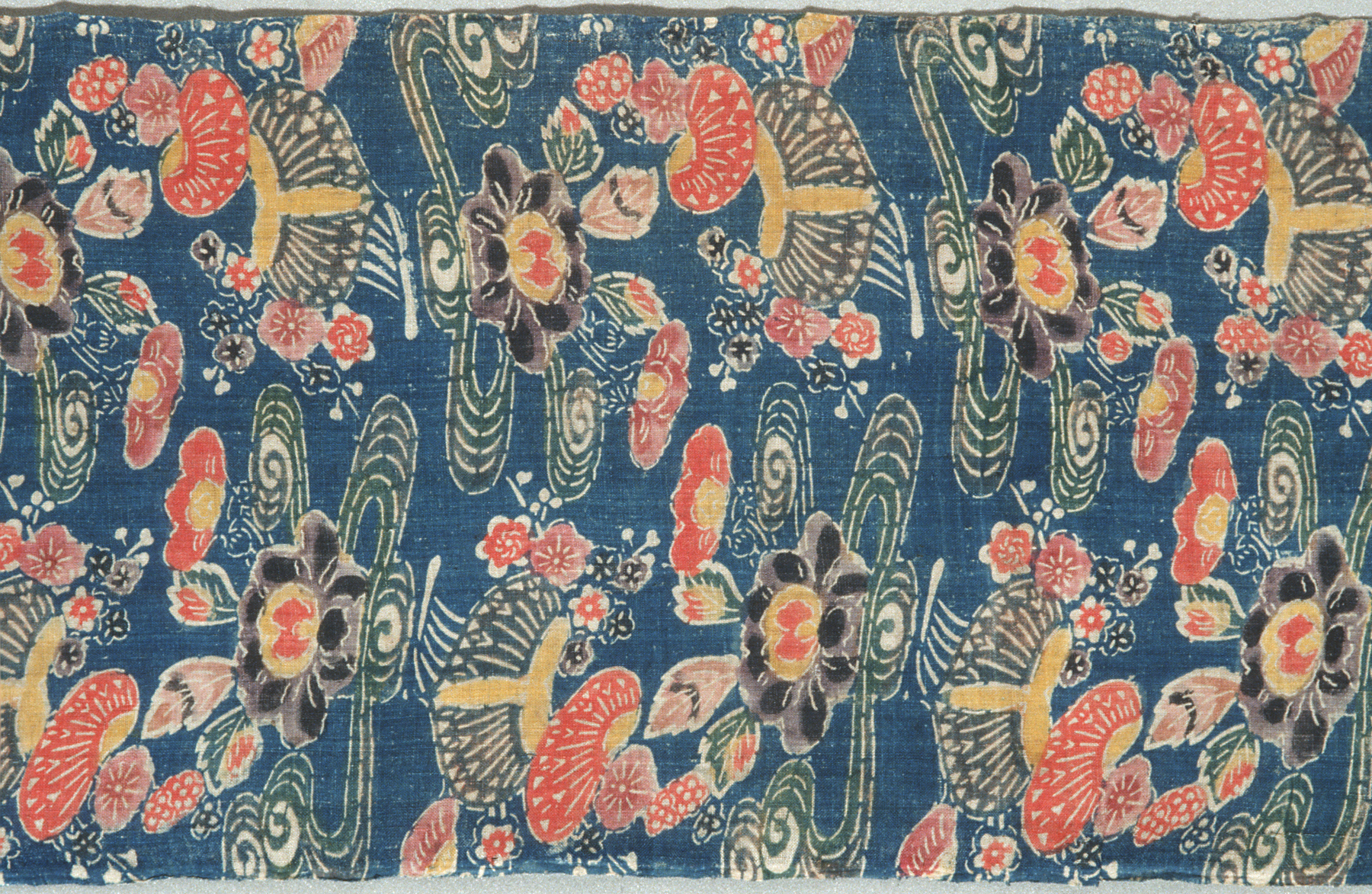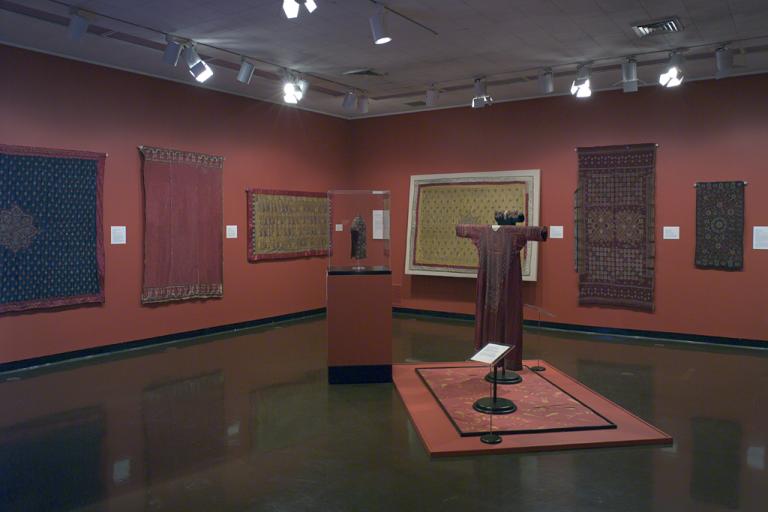Exhibition Label:
“Flowers, Dragons and Pine Trees: Asian Textiles in the Spencer Museum of Art,” Nov-2005, Mary Dusenbury
The term bingata (literally: red pattern) refers to
polychrome textiles with dyed patterns associated with the royal court, aristocracy and wealthy gentry in the kingdom of Ryūkyū (present day Okinawa Prefecture). Bingata dyeing involved several distinct processes, including the use of multiple stencils, paste-resist techniques, immersion dyeing, and the application of dyes and pigments with brushes. The largest and boldest patterns and most brilliant colors were reserved for the royal family and court nobility. The light blue ground and small, overall patterns—worked identically on both sides of a fine ramie fabric—identify this fragment as part of the summer garment of an affluent gentry woman who probably lived in the castle town of Shuri.
Exhibition Label:
Asian Gallery, Spring. 2003
(Didactic panel is from Mary M. Dusenbury’s forthcoming book ‘Flowers, Dragons, and Pine Trees: Textiles from the Spencer Museum of Art.’ (Anticipated publication date: late 2003))
Okinawa Textiles
Located at the confluence of several major ocean currents midway between Tokyo and Southeast Asia, Okinawa is composed of 160 islands extending over a vast area of ocean. Trade with the Asian mainland flourished after the islands were unified under the Ryukyu king in 1429. After the Satsuma from Kyushu invaded Ryukyu in l609, Satsuma and the Bakufu used the archipelago to conduct trade with China.
The weaving and dyeing arts developed in the Ryukyu islands benefited from and were important components of this trade. Bingata dyeing, for instance, is believed by some to have been influenced by techniques practiced in Fujian in southern China. These techniques took on unique characteristics in the Ryukyus, where textiles are often said to closely reflect the beauty of nature in the islands. Bingata is characterized by a clear, brilliant palette with hues that many visitors have likened to the colors of the sea, sky, forests, dazzling coral reefs, and bright flowers of the islands. Bashofu is made with threads spun from the fibers of the ito basho plant, which belongs to the banana family. Thin, cool and durable, it is valued for its comfortable feel in the humid summer weather and was formerly woven for common, everyday use throughout the Ryukyu. To produce just one tan (bolt) of bashofu requires approximately forty ito basho plants, which take three years to mature. Manufacture of a bolt of jofu, the highest grade of cloth, requires fourteen stages of processing.
By the late l6th century, the Ryukyuan court was sending high quality bashofu to the Ming court in China as tribute. In l610, following the Satsuma invasion of Ryukyu, bolts of bashofu were included in the submission gifts that King Sho Nei presented to retired shogun Tokugawa Ieyasu and to his son, the ruling shogun Tokugawa Hidetada. By l638 the domain of Satsuma was selling bashofu in Kyoto as one of its own "famous products."
In l879 the Ryukyu Kingdom was abolished and became Okinawa Prefecture. Amazed at the high level of skills and the variety of traditional crafts when he first visited in l938, Sosetsu Yanagi, founding father of the Japan folk craft movement, declared that Okinawa was a virtual treasure trove of folk crafts. Today Okinawa is referred to in Japan as the "Treasure House of Weaving and Dyeing," and bashofu, bingata, and other Okinawan textiles are prized items in the collections of world-class museums and art galleries.
Exhibition Label:
Asian Gallery, Spring 2003, Youmi Efurd
Bingata refers to polychrome patterned textiles associated with the aristocracy in the kingdom of Ryu-kyu- (modern day Okinawa). Bingata dyeing involved several distinct processes including the use of small stencils, paste resist, immersion dyeing, and the application of dyes and pigments with brushes. The earliest extant fragment of bingata is preserved on the island of Kumejima. It dates from the second half of the fifteenth century and is associated with a young female relative of the local lord. The technique and the one of the most important dye materials, cochineal red (bin), were imported from Fujian province in China probably during the first Sho- dynasty (1422–1470). Bingata textiles were very popular in Japan and may have had an influence on the development of similar dye processes in that country, including tsutsugaki.
This fragment probably came from a garment worn by an aristocratic woman associated with the royal court in the old capital of Shuri, near present day Naha.
Archive Label 2003 (version 2):
This fragment probably came from a garment worn by an aristocratic woman associated with the royal court in Shuri, the former capital of the Ryūkyū Kingdom (near modern day Naha, Okinawa). Bingata refers to multicolored patterned textiles associated with the aristocracy in the kingdom of Ryūkyū. Bingata dyeing involved several distinct processes including the use of small stencils, paste resist, immersion dyeing, and the application of dyes and pigments with brushes. The earliest extant fragment of bingata is preserved on the island of Kumejima. It dates from the second half of the 15th century and is associated with a young female relative of the local lord. The technique and one of the most important dye materials, cochineal red (bin), were imported from Fukien province in China probably during the first Shō dynasty (1422-1470). Bingata textiles were very popular in Japan and may have had an influence on the development of similar dye processes in that country including tsutsugaki.


